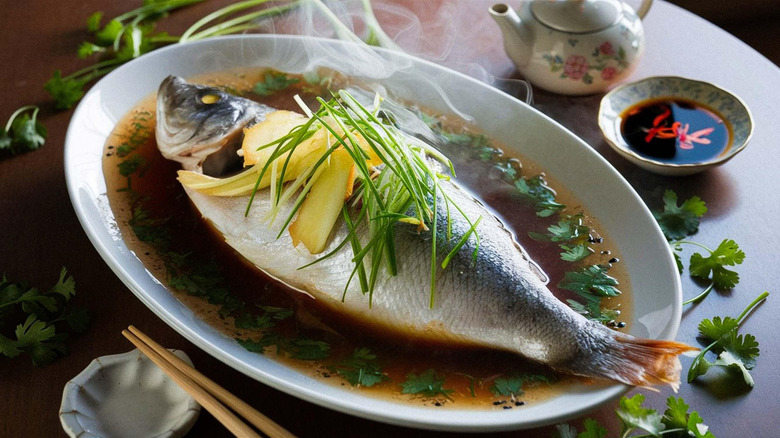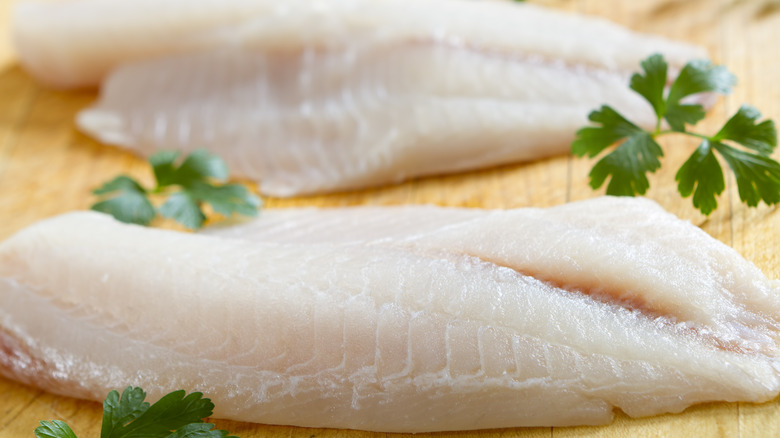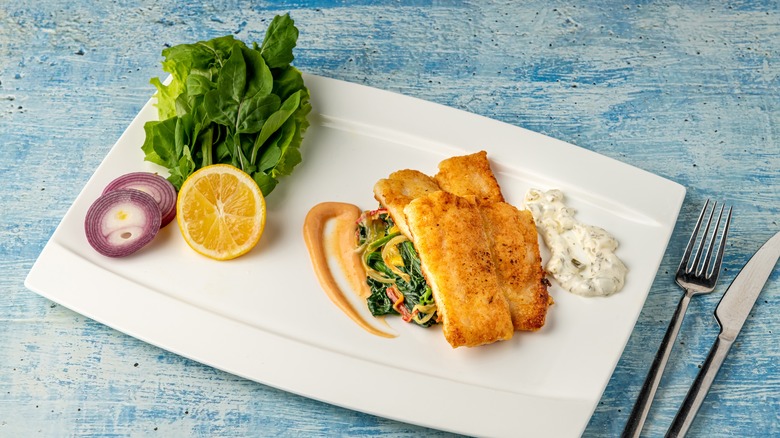Is Basa Fish Safe To Eat Or Should You Avoid It?
Basa is a white fish beloved by many because of its flaky, firm texture and mild flavor infused with a natural hint of salinity. It's a great option for those on the fence about fish and is also popular with chefs because of its versatility. It's also cheaper than cod or haddock, meaning restaurants can stay on budget by using basa for their cuisine instead of other types of fish. Also known as swai and river cobbler, basa is a type of catfish native to the Mekong and Chao Phraya rivers in Southeast Asia.
You'll find it showcased in Indian dishes like basa fish curry, steamed in lime chili garlic sauce in Thailand, and basa in a broth with chili peppers, doubanjiang, and Sichuan peppercorn in Chinese cooking. Basa isn't just limited to Southeast Asian cooking, though that's where it's most popular. You'll also find basa covered in a creamy Tuscan sauce or pan fried with a side of rosemary and roasted garlic potatoes.
There is a downside to basa's meteoric popularity, stemming from the high demand for the fish. While it lives naturally in Southeast Asia's biggest waterways, there isn't enough wild basa to go around. Fish farms around the Mekong River have increased the fish supply, and with it, the potential for environmental and chemical contamination in basa fish sold worldwide. While affordable, basa has landed on lists of fish you should avoid thanks to the potential for contamination.
Concerns include toxin accumulation, mislabeling, and fraud
Basa is a farmed fish, like many other types of fish you might want to avoid if you see them on the menu. Basa fish farms are all located in the Mekong Delta, a place that's had plenty of challenges with industrial and agricultural waste contamination over the years. Fish produced in the delta can have accumulated high levels of heavy metals like mercury, as well as pesticides and other chemicals in their meat, like polychlorinated biphenyls (PCBs) –- a chemical that's been banned for more than 30 years and is still showing up in farmed and wild fish worldwide. Environmental pollutants aren't the only thing contaminating basa fish on the market; the Mekong fish farms use antibiotics and chemicals to control the health of their fish, some of which are banned in other countries.
Harmful compounds can accumulate in the basa that ends up on the market, which incidentally might be sold under false pretenses by wholesalers and restaurants alike. In July 2024, the U.S Food and Drug Administration issued an Import Alert on basa, advising of instances where the fish had been mislabeled.
So, is any basa safe to eat?
Most basa on the market is farmed, not wild, and then exported worldwide. Importing basa fish isn't illegal in the United States if the fish meets health standards set by the U.S. Food and Drug Administration, but it is banned in some other countries due to contamination concerns. Even some states in America have set restrictions on acquiring fish, including Louisiana, Mississippi, and Alabama, stemming from a desire to protect local fishing industries and the health concerns associated with eating basa.
Getting safe basa starts at the store if you're not sourcing it directly from a fishmonger. Because you can't get wild basa in major markets, the best way to ensure your basa fish is safe to eat is to get it from a reputable source, certified as using sustainable and responsible practices by the Aquaculture Stewardship Council. You can find it frozen or fresh in the seafood section at grocers and stores like Walmart.
Choose a whole fish with firm skin, unclouded eyes, and no signs of decay. Check the printed Best By date on the package to get a good idea on the freshness of the fish. Avoid any basa that is slimy or smells off. Use the basa right away or store it in the freezer if you're saving it for later. Freezing inhibits bacteria growth and helps preserve the fish. Cook your basa fish thoroughly to an internal temperature of 145 degrees Fahrenheit to kill any bacteria that might be present.


